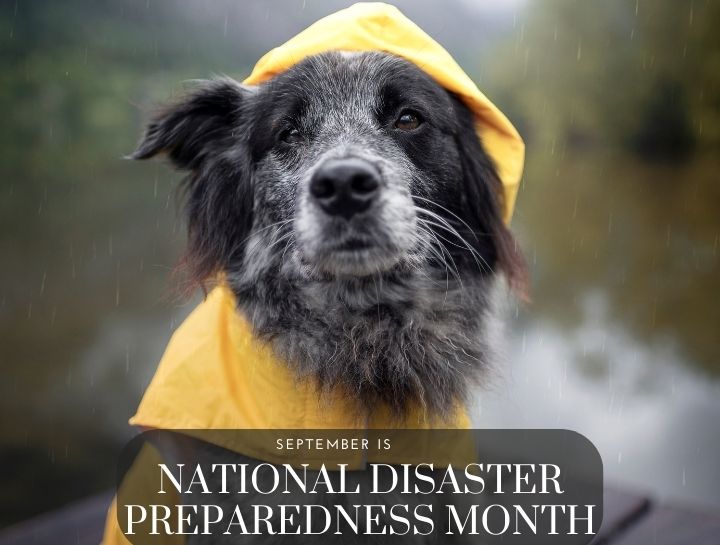National Disaster Preparedness Month

August 24, 2022
Prepare Your Pets for Disasters
September is National Disaster Preparedness Month. Your pets are important members of your family and should be included in your emergency plans.
To prepare for the unexpected, keep your pets in mind as you follow these steps:
Make a Plan
If you have a plan in place for you and your pets, you will likely encounter less difficulty, stress, and worry when you need to make a decision during an emergency.
Include the following in your plan:
- Know what to do with your pet during an evacuation. Many public shelters and hotels do not allow pets inside. Know a safe place where you can take your pets before disasters and emergencies happen.
- Develop a buddy system. Plan with neighbors, friends, or relatives to make sure that someone is available to care for or evacuate your pets if you are unable to do so.
- Have copies of your pet’s vaccination record, and make sure your pet is microchipped. Keep your pet’s photo, address, and phone number up to date in the microchip registry and include an emergency contact outside of your immediate area.
- Keep contact information for your local emergency management office or animal control office and shelters on hand in case you become separated from your pet.
- Include a list of veterinary hospitals, as people often bring lost animals here to be scanned for a microchip or to be held until a shelter can pick them up.
Build a Kit for your Pet
Just as you do with your family’s emergency supply kit, think first about the basics for survival.
Review your kit regularly to ensure that its contents are fresh and replenished.
Some items to include in your kit are:
- Food and Water. Keep several days’ supply of both. Keep food in an airtight, waterproof container, and have a water bowl to use.
- Medicine. Keep an extra supply of the medicine your pet takes on a regular basis in a waterproof container.
- First aid kit. Include items appropriate for your pet’s emergency medical needs.
- Backup collar with ID tag and a harness or leash.
- Have copies of your pet’s registration information in a waterproof container and available electronically.
- Travel bag, crate, or sturdy carrier for each pet.
- Grooming items. Pet shampoo and other items, in case your pet needs some cleaning up.
- A current picture of you and your pet together. If you become separated from your pet, a picture will help you document ownership and allow others to assist you in identifying your pet.
- Sanitation needs. Include pet litter and a litter box, trash bags, and other items to provide for your pet’s sanitation needs.
- Familiar items. Put favorite toys, treats, or bedding in your kit to reduce stress for your pets.
- A towel(s) to use as a makeshift bed, for injuries, or for wrapping cats.
Stay Informed
- Stay informed of current conditions and know how you will receive emergency alerts and warnings.
- Download the FEMA app to get weather alerts for up to five different locations anywhere in the United States.
- Always bring your pets indoors at the first sign or warning of a storm.
For more information about how to prepare your pets, visit Ready.gov/pets.
